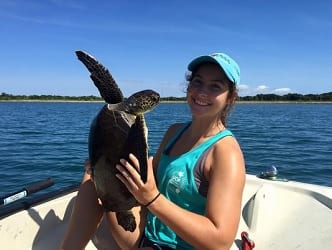Presenting Sea Turtles in Peru

Abigail Hudak poses with a sea turtle. (This photo was taken while conducting permitted research with the UCF Marine Turtle Research Group)
CENTRAL FLORIDA FUTURE – Isabelle D’Antonio, Contributing Writer
In February 2016, hundreds of sea turtle enthusiasts and researchers from around the world will gather in Lima, Peru, for the 36th annual International Sea Turtle Symposium to present their research and discuss conservation efforts.
This year, junior Abigail Hudak, UCF biology major, will be one of them.
She has been invited to present the research on sea turtles that she gathered while interning with the UCF Marine Turtle Research Group on the Archie Carr National Wildlife Refuge in Melbourne Beach.
“The Archie Carr National Wildlife Refuge is a unique private public partnership with many organizations playing important parts to improve sea turtle survival,” said Anibal Vazquez, the refuge manager. “The main things we do are [to] provide dark beaches that are critical for nesting. Along with owning some land, we also facilitate research and provide public outreach to educate our visitors to improve their behavior.”
Hudak is presenting her ongoing research about how dune nourishment projects have changed over time at the refuge and how they affect green turtle and loggerhead nesting success. Dune nourishment, the replacing of sand on dunes, helps prevent erosion, which allows sea turtles to continue nesting. The UCF Marine Turtle Research Group has been monitoring the differing effects dune nourishment has on the turtles’ nesting successes.
“Using [this] data, we aim to understand the differing effects of dune restoration on loggerheads and green turtles, and how to improve dune restoration projects in the future,” Hudak said.
The research included a lot of late nights and hard work.
“Over the summer, we would work night shifts to study nesting females on the beach, which included tagging the turtles and taking biopsy samples and measurements,” she said. “In the mornings, we would run surveys to count the number of nests that occurred on the beach and how many false-crawls.”
Hudak said that though challenging, she enjoyed the work. “Working on the beach with an awesome group of people was one of my favorite parts of the experience,” she said. Hudak said that she also enjoyed getting the hands-on experience of working with the turtles.
“Sea turtles have been around for 100 million years, and to see something so historic and almost dinosaur-like is crazy,” she said. “Seeing a leatherback makes me feel like I am in another time period.”
Ph.D. student Chris Long, who worked with Hudak researching the turtles, isn’t at all surprised by her success. “Abby has been a great addition to our research group,” Long said. “Her hard work and positive attitude really keep us going during the long nights of tagging turtles and marking nests.”
Long, who encouraged Hudak to join the Marine Turtle Research Group, said that he is incredibly proud of her accomplishment.
“A lot of people just go through the motions in their day-to-day life, but Abby strives to give her best effort in all aspects of her life,” he said. “Presenting at an international meeting is a great achievement, and the extra effort she put in to make it happen is the mark of great scientist in the making.”
For Hudak, February 2016 can’t come soon enough. “Being on another continent with a group of scientists with similar passions and experiencing a culture I’ve never seen before is awesome,” she said. “I’m so excited and honored. To be able to do something like this as an undergraduate and be able to put this on my resume is amazing.”
To read the original story click here.
